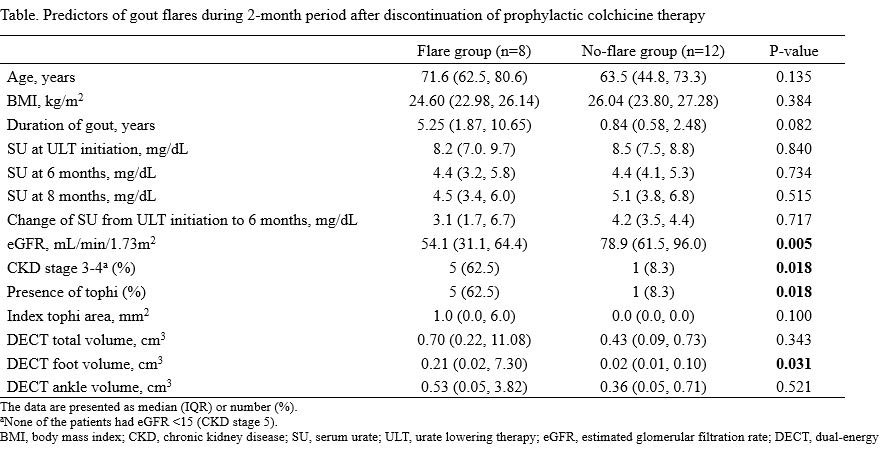Session Information
Date: Monday, November 14, 2022
Title: Metabolic and Crystal Arthropathies – Basic and Clinical Science Poster
Session Type: Poster Session D
Session Time: 1:00PM-3:00PM
Background/Purpose: To investigate whether monosodium urate (MSU) deposition measured by dual-energy computed tomography (DECT) could help predict acute flares after discontinuing colchicine prophylaxis in patients with gout.
Methods: This prospective observational pilot study included patients with gout meeting the 2015 ACR/EULAR gout classification criteria who received urate lowering therapy (ULT) and a prophylactic dose of colchicine for 6 months. DECT was performed at the time point when colchicine was discontinued. Images of a preselected unilateral foot and ankle were analyzed for the measurement of MSU volume by a musculoskeletal radiologist. Patients were divided into those who had a flare and those who did not during a 2-month period following colchicine discontinuation. Differences in clinical and DECT findings between the two groups were analyzed. The predictive value of MSU volume for flares was assessed using the area under the receiver-operating-characteristic curve (AUC).
Results: Twenty-three patients were enrolled: the MSU volume of 20 patients were assessed. The index tophi area on physical exam well correlated with the total MSU volume (rho 0.575, p=0.010). Eight (40%) of the 20 patients experienced a flare over a 2-month period after discontinuing colchicine. The flare group had more tophi on physical exam (62.5% vs. 8.3%, p=0.018) and more patients with chronic kidney disease (CKD) (62.5% vs. 8.3%, p=0.018). The no-flare group had considerably lower foot MSU volume than the flare group (0.02 vs. 0.21 cm3, p=0.031). The foot MSU volume yielded an AUC of 0.79 for predicting a flare after discontinuing colchicine.
Conclusion: Our study shows that the presence of tophi and CKD may require a longer period of colchicine prophylaxis. Patients with little or no MSU deposits on the foot/ankle 6 months after initiating ULT had a lower risk of flare after discontinuing prophylaxis. Longitudinal measurements of MSU volume in patients with a high initial urate burden may help determine the optimal duration of prophylaxis.
To cite this abstract in AMA style:
Kim M, Kim M, CHOI S, Jung Y, Jung J, Kim J, Chai J, Shin K. The Utility of Dual-energy Computed Tomography in Gout Patients During Urate Lowering Therapy [abstract]. Arthritis Rheumatol. 2022; 74 (suppl 9). https://acrabstracts.org/abstract/the-utility-of-dual-energy-computed-tomography-in-gout-patients-during-urate-lowering-therapy/. Accessed .« Back to ACR Convergence 2022
ACR Meeting Abstracts - https://acrabstracts.org/abstract/the-utility-of-dual-energy-computed-tomography-in-gout-patients-during-urate-lowering-therapy/


